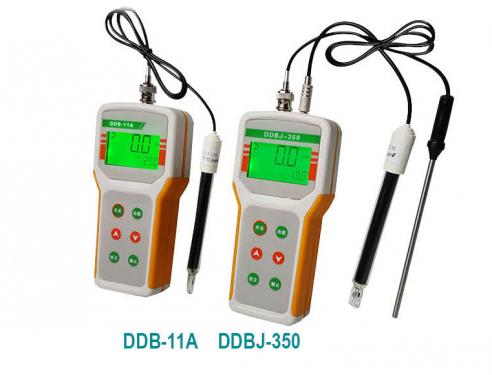technical performance
range of conductivity measurement: (0 ~ 199.9)μ s/cm; (200 ~ 1999) & mu; s/cm; (2.00 ~ 19.99) ms/cm; (20.0 ~ 199.9) ms/cm;
resolution: 0.1/1μ s/cm; 0.01/0.1 ms/cm;
accuracy: electrometer :± 1.0% fs. matching: & plusmn; 1.5% fs
10-50 ℃ temperature compensation: automatic or manual compensation,
basic configuration: djs-1e (platinum black) electrode; temperature electrode, 1408-mu; standard calibration bench for s/cm conductivity; four dc1.5v batteries
the working conditions
environmental temperature: 0 ~ 40 ℃ relative humidity: < 85%
power supply: 7 dc1.5 4 v batteries
no significant vibration
in addition to the geomagnetic otc no other strong magnetic field disturbance.
optional constant electrode specification: 0.1, 1, 10
shape to the size and weight: 180 & times; 80 & times; 30 mm (long & times; wide & times; high) 0.5 kg
ii. working principle of the instrument
in electrolyte solutions, charged ions, acting on an electric field, produce a movement that transfers current. its conductivity is represented by the conductivity g, and its value is the reciprocal of the resistance. the g = 1 / r
in order to test the magnitude of conductance, two electrodes composed of metal plates can be inserted into the solution to form a conductance cell and the resistance between the plates can be measured. according to ohm's law, the resistance is proportional to the distance l (cm) between the plates and inversely proportional to the area a (cm2) of the plates. r = & rho; & bull; l/a
& rho; where is the resistivity, and let its inverse be the conductivity and expressed as k, then k = 1/ρ
for a certain electrode, the ratio of the effective distance l between the electrode plate and the area a of the electrode plate is called the electrode constant of this electrode, which is represented by j, namely j = l/a
according to the above types:
g is equal to k over j, k is equal to g• j
the unit of conductance g is siemens and the unit symbol is s.
1s = 103ms = 106μ s.
the common units of conductivity k are ms/cm and &mu. s/cm.
this method to test the conductivity instrument, is by the dc voltage generated by the oscillator on the electrode (plus the purpose of the ac voltage is to avoid causing polarization of electrode), generate electricity conductivity in the pool, the current is proportional to the electrical conductivity of the test solution, the i-v conversion, amplification, detection, transformation of dc voltage, through temperature compensation and so on, finally by the a/d converter into digital signal, through the microcomputer. the whole process is controlled and processed by microcomputer.
